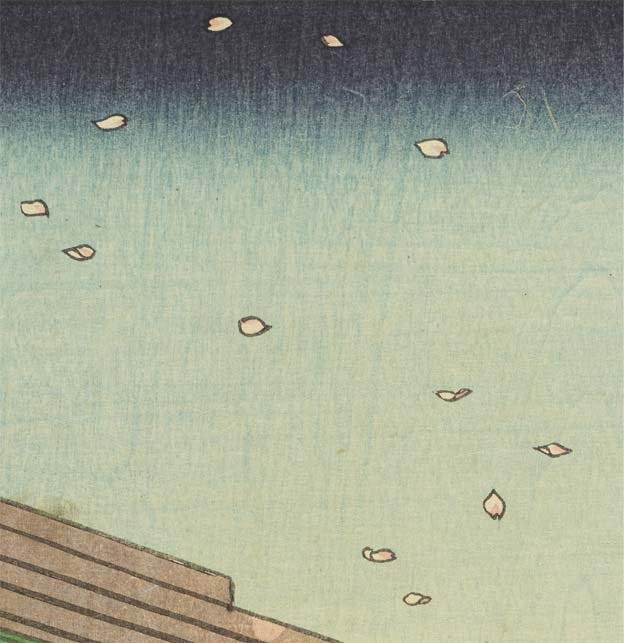March 26 - 30
桜始開
さくら はじめて ひらく
Sakura hajimete hiraku
Cherry blossoms open
Let’s start with a poem:
春風の 花を散らすと 見る夢は 覚めても胸の さわぐなりけり haru kaze no hana wo chirasu to miru yume wa samete mo mune no sawagu narikeri the spring wind scattering blossoms I saw it in a dream but when I awoke the sound was still rustling in my breast
This is just one of many, many, many verses that have been written about that most famous of Japanese flowers: the sakura (桜), or cherry blossom tree. This particular one being from the 12th century monk and poet, Saigyō Hōshi. Before haiku settled into the 5-7-5 form we know today, his travels and writings inspired countless wandering artistic souls, including the well-known haiku master Matsuo Bashō.
I chose Saigyō’s poem to open with not only because I felt it connected well to other kō we’ve spoken about thusfar, with its spring winds and scattering blossoms, but also because it captures elegantly the themes that sakura represent in Japan: fragile joy, melancholy beauty, warm moments that pass like a dream but stay in your heart. Only in full bloom for a week in any given area, the opening of the sakura flowers draws the attention of the nation in a way few other seasonal events do.
Rather than write endlessly about what sakura mean to Japanese culture (which others have done very thoroughly), I thought instead we could explore that through a few centuries of haiku. I think you’ll pick up the themes.
Why don’t we start with Bashō?
春風に 吹き出し笑う 花もがな haru kaze ni fukidashi warau hana mo gana a spring breeze is blowing I’m bursting with laughter wishing for flowers
That haru kaze comes up a lot, not just in poetry but in conversation. As we mentioned way back in Kō 1: a “haru kaze” is a wind that carries a warmth on it indicative of spring. Bashō also uses the double-meaning wordplay of “warau” that we talked about in Kō 8, which can be a smile spreading across a face or blossoms spreading across a landscape.
Another from Bashō, joining the passing of time with the motif of sakura. Just as winter ended, so will spring. Just as one day ends, another begins.
春の夜は 桜に明けて しまいけり haru no yo wa sakura ni akete shimai keri A lovely spring night suddenly vanished while we viewed cherry blossoms
Here’s one from Kobayashi Issa, one of the Four Great Poets of Haiku alongside Bashō, Buson, and Shiki. This was written in his younger years.
さすが花 散るにみれんは なかりけり sasuga hana chiru ni miren wa nakari keri the blossom is sure that even though it will fall there are no regrets
Again from Issa, returning to his hometown in his 50s after decades away:
見かぎりし 古郷の桜 咲にけり mikagirishi furusato no sakura saki ni keri the cherry blossoms in my abandoned hometown blooming just the same
One of our other Greats, Yosa Buson, perhaps watching a warm breeze rustle the trees:
春の海 終日のたり のたりかな haru no umi hinemosu notari notari kana vernal seas… all day long swelling, falling swelling, falling
And let us finish with the last of The Four Greats, Shiki, who perhaps understood better than most the transience that sakura represent—at 21 he was diagnosed with tuberculosis, and wrote his many of his haiku with the knowledge that his life was ending.
夕月や 一かたまりに 散る櫻 yūzuki ya hitokatamari ni chiru sakura moon at twilight, a cluster of petals falling from the cherry tree
I won’t break down and analyze all the Japanese in the haiku above, but the three kanji characters of this kō are straightforward and mostly familiar to us by now. 桜始開 is comprised of sakura (桜), hajimete (始), and hiraku (開). Sakura we have…well covered here, and “hajimete” has featured in a few kō, including the one just before this. “Hiraku” we covered only in reading, during Kō 7, when the insects opened their doors, but that was using a different character in a non-standard way. This “hiraku” is the standard “hiraku” that you’ll find labeling doors and elevator buttons.
While there are quite literally dozens of seasonal kigo words featuring sakura or relating to this period, the two I’d like to highlight are pretty useful and common. The first being hana-fubukui (花吹雪). Literally meaning “flower snowstorm,” the term refers to the way that falling sakura petals tend to float gently to the ground like white-pink snowflakes. The best way to enjoy this sight is our second word: hanami (花見), or “flower-viewing.” A tradition going back at least 1,300 years in Japan, hanami is quite simply the act of sitting under some flowering trees in nice weather while eating and drinking with good company. It is one of the best things you can do in Japan.
Consequently, if you have a Japan trip coming up soon and are afraid you’ve missed the sakura blooming: might I suggest Hokkaido as a destination? The northernmost island is the last to see them, going as late as the start of May. Or it’s never too early to plan for next year. Just be sure to check the Japan Weather Association’s official forecast for sakura blooming (provided in English courtesy of Japan Guide).
In the event that all that old poetry’s got you craving something a bit more modern, I leave you with the smash 2006 single from Ikimono Gakari: appropriately titled “SAKURA”
See you next kō~
[Images & info by kurashikata.com, kurashi-no-hotorisya.jp, and Wikipedia except where otherwise noted]
just try getting that chorus out of your head
translation from the Classical Japanese Database
translation from this Matsuo Basho blog
from Sam Hamill’s The Essential Bashō
this one’s translated by yours truly
me again!
by Adam L. Kern, The Penguin Book of Haiku











The cherry blossom petals are starting to fall here in North Carolina. Hana-fubukui!!! I love knowing there’s a word for this.🌸